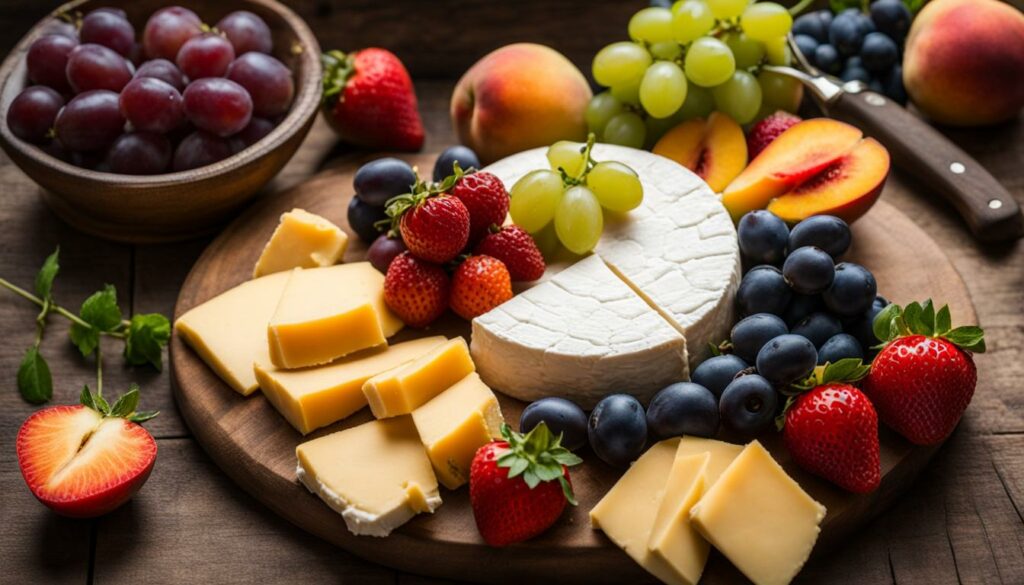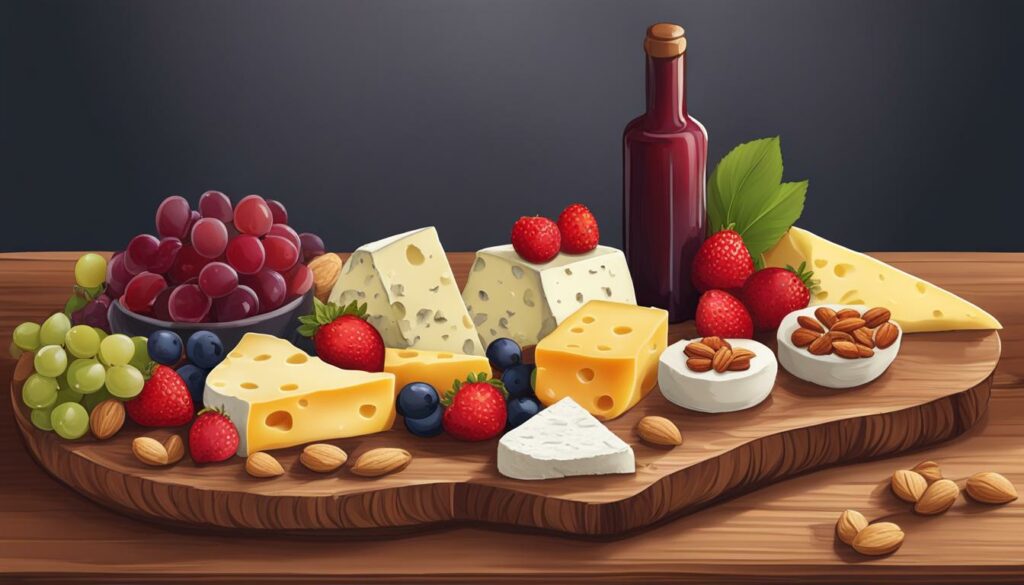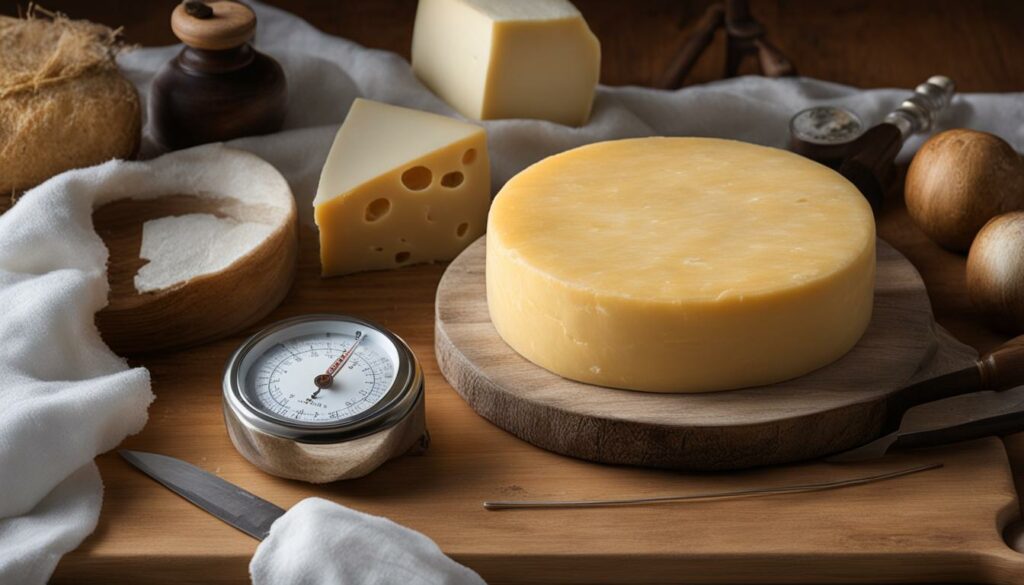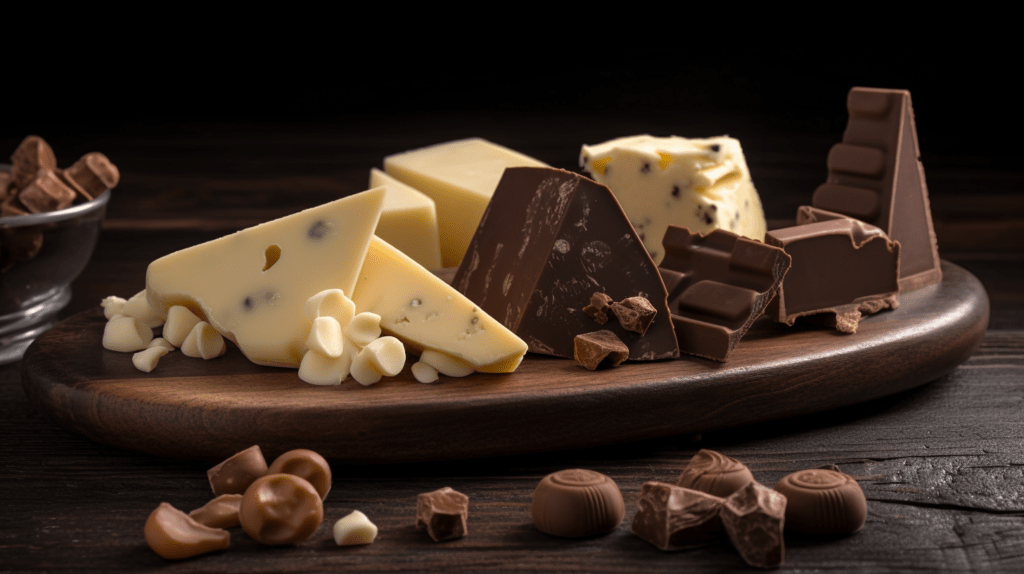Welcome to a world of exquisite flavors and creamy indulgence. If you’re a cheese lover, then you’re in for a treat with Brie cheese – one of the best, gourmet, and most beloved cheeses in the world. Brie cheese is known for its rich, creamy texture and delicious taste that instantly transports you to the picturesque countryside of France. Whether you’re looking for a soft and authentic French Brie cheese or an artisan-crafted masterpiece, Brie cheese has something special to offer.
Imagine the velvety melt-in-your-mouth texture of Brie cheese, its buttery and slightly nutty flavor giving way to a subtle earthiness that lingers on your palate. It’s a true gastronomic experience that captivates your senses. Brie cheese is perfect for those who appreciate a delectable and sophisticated taste, with each bite delivering pure bliss.
Experience the epitome of French cheese-making tradition with Brie cheese. Made from cow’s milk and originating from the historical region of Brie in Northern France, every bite of authentic Brie cheese tells a story centuries in the making. Its soft and edible pale yellow rind is a testament to the meticulous craftsmanship that goes into its production.
Whether it’s a gathering of friends, a cozy night in, or a special occasion, Brie cheese is a versatile delicacy that can be enjoyed in various ways. From spreading it on crusty bread to pairing it with fruits, nuts, and even honey, the possibilities are endless. Brie cheese is incredibly versatile, complementing a wide range of flavors and textures.
So why wait? Graced with a rich history and a reputation as the “King of Cheeses,” Brie cheese is a culinary masterpiece that continues to delight cheese connoisseurs and food lovers worldwide. Explore the delightful world of Brie cheese today and indulge in its creamy, irresistible goodness.
The History of Brie Cheese
Brie cheese has a deep-rooted history that can be traced back to the Middle Ages. According to historical accounts, this beloved cheese was first crafted by the monks residing in the monastery of Rueil en Brie, located in France. Renowned for its bold and rich flavor, Brie cheese earned the prestigious nickname “Le roi des fromages,” which translates to the “King of Cheeses.”
“Le roi des fromages” – The King of Cheeses
The popularity of Brie cheese quickly spread among the French royalty, who appreciated its exquisite taste and indulgent texture. Notable figures such as Charlemagne and King Philip II Augustus held a fondness for this cheese, appreciating its unique flavors. Even the famous King Louis XVI was known to have a deep affection for Brie de Meaux, a specific variety of Brie cheese.
The royal history of Brie cheese intertwines with the fascinating stories of French monarchs and their culinary preferences. It became an iconic symbol of the French gastronomy, representing elegance and refinement in the realm of cheese.
The Monastery of Rueil en Brie

The monastery of Rueil en Brie, where Brie cheese is believed to have originated, played an instrumental role in its creation. This historical monastery was nestled within the breathtaking countryside of France, where dedicated monks honed their artisanal cheese-making skills, producing the exquisite Brie cheese that would eventually captivate the palates of many.
With its remarkable and rich history, Brie cheese continues to be cherished and celebrated as a culinary treasure. Its royal lineage and the meticulous craftsmanship that goes into its production make Brie cheese a truly distinct and indulgent delight for cheese enthusiasts worldwide.
The Production of Brie Cheese
Brie cheese is renowned for its exquisite flavor and creamy texture. It is made using traditional cheese-making techniques that have been perfected over centuries. The production process begins with Brie de Meaux, the most famous variety of Brie, in the Brie region of France.
To create Brie de Meaux, raw cow’s milk is carefully fermented and coagulated. The curds are then gently scooped into molds, where they are salted to aid in the formation of the cheese. Once molded, the cheese is sprayed with Penicilium, a type of mold, which creates the distinct white bloom on the rind.
After the initial stage, Brie de Meaux is aged for approximately six weeks in a cellar. During this time, the cheese is turned twice a week to ensure even distribution of flavors and textures. This aging process allows the cheese to develop its characteristic creaminess and delicate taste.
Another variety of Brie, known as Brie de Melun, undergoes a longer fermentation and aging process. This results in a slightly funkier flavor and a more pronounced aroma, appealing to those seeking a bolder taste experience.
The careful attention to detail, adherence to traditional techniques, and dedication to quality make Brie de Meaux and Brie de Melun exceptional examples of artisanal cheese craftsmanship.
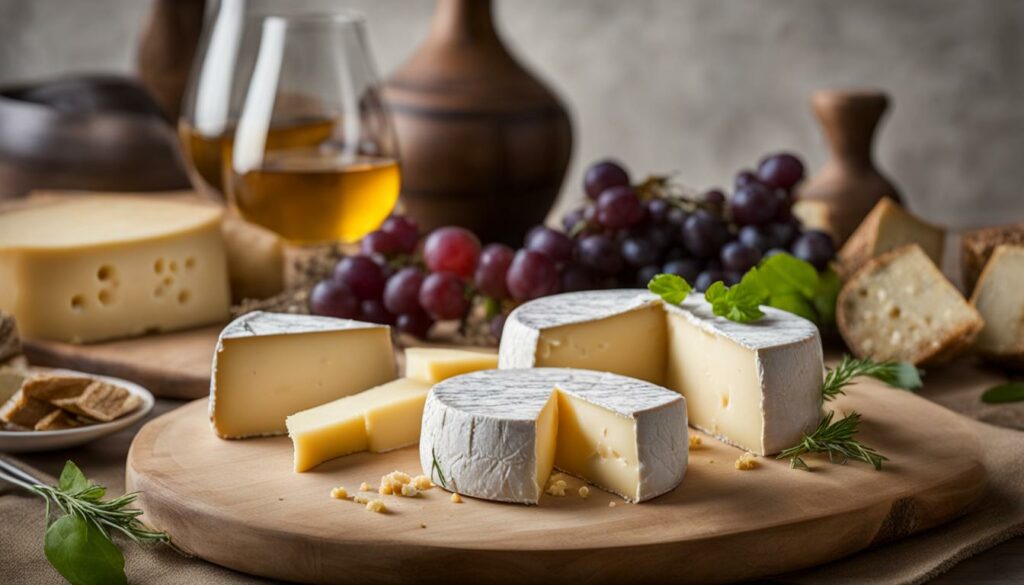
Brie de Meaux, the most famous variety of Brie, undergoes a traditional cheese-making process, including aging in a cellar.
Serving and Pairing Brie Cheese
Brie cheese is a versatile and delicious cheese that can be enjoyed in various ways. Whether you’re serving it as an appetizer, dessert, or incorporating it into your main course, Brie cheese is sure to delight your taste buds. Here are some ideas for serving and pairing Brie cheese:
Traditional Accompaniments
When serving Brie cheese, it is customary to pair it with crusty bread or crackers. The crispy texture of the bread provides a perfect contrast to the creamy and smooth texture of the cheese. You can also try serving it with thinly sliced baguette or toasted crostini for a delightful twist.
To enhance the flavor of Brie cheese, consider adding some delicious accompaniments. Fruits such as apples, pears, or grapes are excellent choices. The sweet and tangy flavors of these fruits complement the rich and creamy nature of Brie cheese. Alternatively, you can also serve it with a variety of nuts, like walnuts or almonds, which add a crunchy texture to every bite.
Another popular accompaniment for Brie cheese is honey. The natural sweetness of honey beautifully enhances the buttery flavor of the cheese. You can drizzle a little honey on top of each slice or serve it in a small dish alongside the cheese. For an extra touch of indulgence, try adding some fig jam or preserves to your cheese platter.
Perfect Pairings
When it comes to pairing Brie cheese with beverages, there are several options that complement its flavors. Here are some recommendations:
- Wine: Brie cheese pairs well with both red and white wines. For red wine lovers, opt for a Pinot Noir or a Merlot to complement the flavors of the cheese. If you prefer white wine, a Chardonnay or a Sauvignon Blanc can be excellent choices.
- Champagne: The effervescence of champagne makes it a classic pairing for Brie cheese. The crisp and bubbly nature of champagne cuts through the richness of the cheese, creating a perfect harmony of flavors.
- Beers: While wine and cheese are often seen as a classic pairing, Brie cheese can also be enjoyed with certain types of beers. Scotch Ale or Pilsner beers can provide a refreshing contrast to the creamy and mild flavors of Brie.
When serving Brie cheese, it’s important to remember that the goal is to enhance its delicate flavor without overwhelming it. By choosing complementary ingredients and beverages, you’ll create a harmonious and delightful culinary experience.
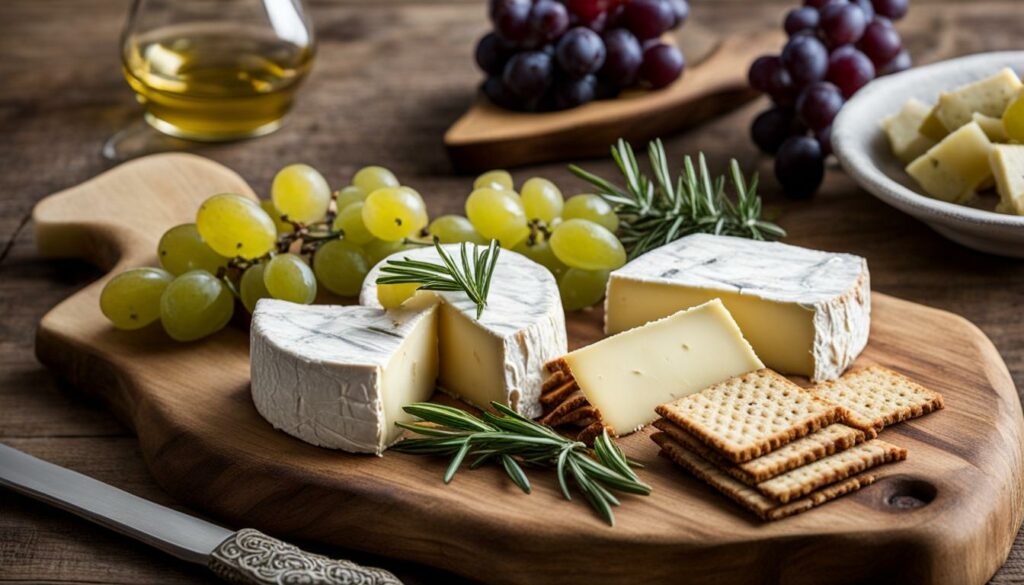
| Brie Cheese | Accompaniments | Pairings |
|---|---|---|
| Crusty bread or crackers | Fruits (apples, pears, grapes) | Red wine (Pinot Noir, Merlot) |
| Baguette or crostini | Nuts (walnuts, almonds) | White wine (Chardonnay, Sauvignon Blanc) |
| – | Honey, fig jam | Champagne |
| – | – | Beers (Scotch Ale, Pilsner) |
Conclusion
Brie cheese is a versatile and delicious cheese with a rich history. It has a creamy texture, a mild, buttery flavor, and is often described as the “King of Cheeses.” Whether enjoyed on its own or incorporated into various dishes, Brie cheese is a gourmet delight that adds richness and flavor to culinary creations.
From its origins in the historical region of Brie to its popularity worldwide, Brie cheese continues to be a favorite among cheese connoisseurs and a staple in French households. Its renowned reputation as a high-quality cheese has made it a sought-after choice for those looking to indulge in a gourmet experience. The creamy, indulgent goodness of Brie cheese is sure to satisfy your taste buds and elevate any dish it graces.
So why not explore the delights of Brie cheese today? Whether you enjoy it on a cheese platter with crusty bread and fruits, melt it into a warm and gooey sandwich, or use it to create a decadent appetizer, Brie cheese will always bring a touch of luxury and sophistication to your table. Embrace the creamy, indulgent goodness of this regal cheese and let it elevate your culinary creations to new heights.
FAQ
What is Brie cheese?
Brie cheese is a popular cheese that originated in northern France. It is made from cow’s milk and has a pale yellow, soft, edible rind. Brie cheese has a creamy texture and a mild, buttery flavor with earthy and nutty undertones.
Why is Brie cheese called the “King of Cheeses”?
Brie cheese is often referred to as the “King of Cheeses” due to its rich flavor and illustrious royal history. It gained popularity among French royalty and even King Louis XVI was known to be a fan of Brie de Meaux, a specific variety of Brie cheese.
Are there different varieties of Brie cheese?
Yes, there are different varieties of Brie cheese. Brie de Meaux is a specific variety that is particularly famous. It is aged for at least four weeks to develop its unique flavor and texture. Another variety, Brie de Melun, is fermented and aged for a longer time, resulting in a slightly funkier flavor.
How is Brie cheese made?
Brie cheese is made using traditional cheese-making techniques. Brie de Meaux, the most famous variety, is produced in Meaux in the Brie region of France. It is made from raw cow’s milk, which is fermented and coagulated before being placed in molds and salted. The cheese is then sprayed with Penicilium to develop its white bloom on the rind. Brie de Meaux is aged for around six weeks in a cellar and is turned twice a week during this period.
How should I serve Brie cheese?
Brie cheese can be served as an appetizer, dessert, or part of the main course. It is traditionally served with crusty bread or crackers. Brie cheese also pairs well with fruits such as apples, pears, or grapes. Accompaniments like fig jam or honey can enhance the cheese’s flavor.
What are the best pairings for Brie cheese?
Brie cheese pairs well with red wine from Bourgogne or Bordeaux, champagne, and certain types of beers such as Scotch Ale or Pilsner. It is important to choose complementary ingredients that enhance the delicate flavor of Brie without overwhelming it.

